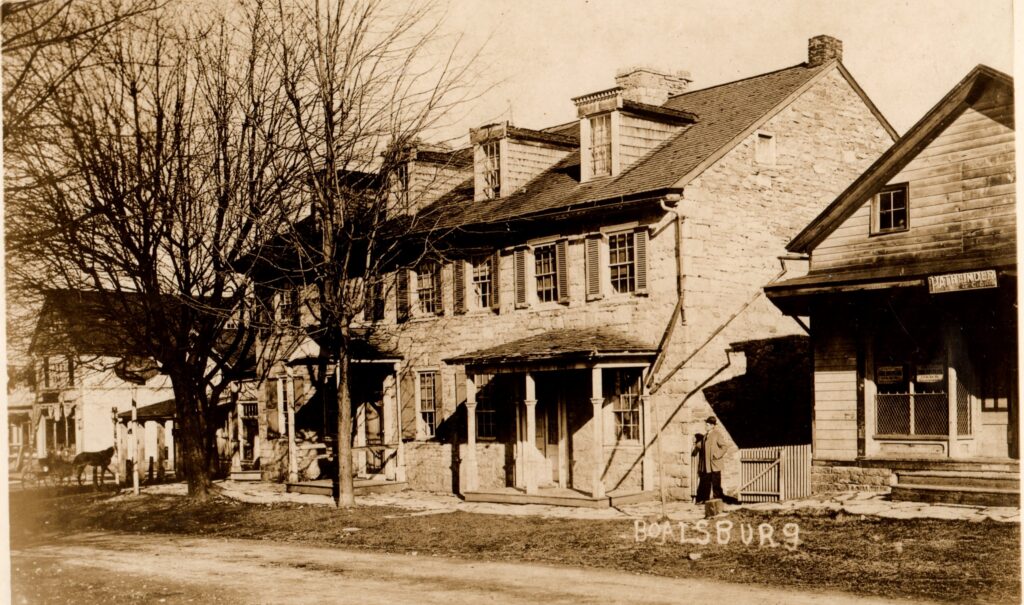Duffy’s Tavern is a historic eating and drinking establishment in the village of Boalsburg that is now in its third century. The tavern was built in 1819 on the diamond by Colonel James Johnston, who envisioned a place for lodging and food at the crossroads of the two major stagecoach routes in Harris Township.
Originally known as the Boalsburg Tavern, the two-story structure has twenty-two-inch walls built with stone quarried locally and cut on site. A visitor to the tavern when it opened entered through the front door into the center hall. To the left was the “big room” with a large central fireplace that became the taproom where people gathered for drinks. To the right was another building-length room with two fireplaces where dined. The second floor held sleeping rooms and a ballroom.

The tavern provided stagecoach riders a hearty meal and a bed where they could spend the night. It also became the center of social activity in the village.
Stagecoaches brought mail and newspapers to the village. Residents came to the tavern regularly to the pick up their mail and learn of what was happening elsewhere from guests. The tavern also was a popular spot for local card games as well as dances.
The Johnston family sold the tavern in 1865 and the next two owners stopped serving alcohol. The bar was removed and an open porch was built on the west side of the building.
Colonel Theodore Boal purchased the tavern in 1905, and over the years sold it to several people who operated it. One of the innkeepers was George Ferguson and his wife, a black couple from Philipsburg. The three Ferguson children were born in one of the upstairs rooms.
A fire on Valentine’s Day in 1934 swept through the tavern. Everyone inside, including innkeeper Myrtle Thompson, escaped unharmed. Fire companies from Boalsburg and State College battled the fire for hours before extinguishing it.
The heavy stone walls saved the basic structure, but the second floor was destroyed and the first floor was badly damaged. Boal, who was struggling financially at the time, abandoned the tavern and the blackened wreckage remained on the site for three years.
Roanna Hill Winsor bought the charred structure at a sheriff’s sale for $500. Winsor, known as “Billy,” was a 1923 graduate of Penn State who was living in Pittsburgh at the time, but she moved to Centre County to operate the tavern. Using just-completed plans of the building by the Historic American Building Survey, Winsor rebuilt it close to the original design. The tavern reopened in 1938.

Thanks to Winsor’s careful restoration, the tavern retains many original elements, including both front doors, fireplace mantels, interior doors and cabinets, and a large volume of hardware. High on the facade is a stone set by Colonel Johnston with his and his wife’s names and the date. Winsor lived in an apartment on the second floor of the tavern until World War II began when she joined the U.S. Navy Waves.
After the war, Winsor sold the tavern to Harry and Mary Duffy, who operated it from 1946 to 1971. They changed the name to Duffy’s Tavern and painted over the original Boalsburg Tavern sign to reflect the new name. (That repainted original sign hangs on the wall in the back bar room.) They also enclosed the side porch.
In recent decades, there have been several owners of the tavern. However, the purpose of the establishment has remained the same: to provide food, drink, and a place of comradery for Boalsburg residents and people visiting the village. The tavern is one of the buildings in the Boalsburg Historic District that is on the National Register of Historic Places.
Cathy Horner
Sources:
Horner, Cathy. The History of the Boalsburg Tavern – and the Woman Who Saved It. State College: Centre County Historical Society, 2019.
National Register of Historic Places Nomination Form, Boalsburg Historic District.
State College Times, February 15, 1934.
First Published: June 21, 2021
Last Modified: November 3, 2021
